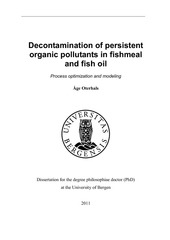| dc.contributor.author | Oterhals, Åge | eng |
| dc.date.accessioned | 2011-10-20T12:22:56Z | |
| dc.date.available | 2011-10-20T12:22:56Z | |
| dc.date.issued | 2011-10-07 | eng |
| dc.identifier.isbn | 978-82-308-1830-5 (print version) | en_US |
| dc.identifier.uri | https://hdl.handle.net/1956/5129 | |
| dc.description.abstract | Persistent organic pollutants (POPs) are fat soluble chemical substances that persist in the environment and bioaccumulate in the food chain. Through long-range environmental transportation by air, water and migratory species they are transferred to new locations distant from the source of release and might cause adverse effects to human health and to the environment. POPs comprise pesticides, industrial chemicals and unwanted by-products. The European Commission has implemented food and feed legislations concerning maximum permitted levels (MPLs) of polychlorinated dibenzo-p-dioxins and furans (PCDD/Fs), dioxin-like polychlorinated biphenyls (DLPCBs), polycyclic aromatic hydrocarbons (PAHs) and organochlorine pesticides (OCPs). Fish and consequently fishmeal and fish oil has been identified as one of the most important contributors to the level of dioxins and DL-PCBs in food and feed products. Fish caught in some of the North-European fishing areas contain high dioxin and PCB levels resulting in fishmeal and oil with WHO-PCDD/F-PCB-TEQ levels above the maximum permitted. To meet the new industrial and socialeconomic challenges there is a need for development of cost-effective decontamination technologies. Efficiency and limitations of alternative decontamination technologies to reduce the level of PCDD/Fs, DL-PCBs and polybrominated diphenyl ether flame retardants (PBDEs) in fishmeal (i.e., mechanical fat separation, organic solvent extraction and oil leaching) and fish oil (i.e., activated carbon (AC) adsorption and short-path distillation (SPD)) have been studied in this thesis. Factorial design experiments, response surface methodology and quantitative structure property relationships (QSPRs) have been utilized to model and optimize the fish oil decontamination alternatives. The trapping mechanisms for non- and mono-ortho PCBs on AC have been studied by use of molecular dynamics simulations. Optimization of the existing mechanical fat separation steps in the fishmeal process is expected to be the most cost-effective way to reduce the POPs content. However, the obtainable effects are limited (estimated to maximum 20-30%) and have to be combined with organic solvent extraction if high decontamination rates are needed. The feasible use of a new oil leaching process has been studied and found to give effects comparable to hexane and isopropanol extraction of fishmeal (i.e., > 75%). AC adsorption of PCDD/Fs is highly effective with obtainable WHO-TEQ-reduction of 99%. Adsorption of DL-PCBs is less effective and dependent on orthosubstitution, i.e., non-ortho-PCBs are adsorbed more effectively than mono-ortho- PCBs, with maximum obtained levels of 87% and 21%, respectively. Compliance with present feed and food WHO-PCDD/F-PCB-TEQ legislations in fish oil can be achieved based on AC adsorption. The adsorption process had no effect on PBDEs. The selectivity can be explained based on dispersive electron interaction affected by sorbate planarity and steric effects and presence of electrostatic forces. Within each of the studied homologue groups, the volatility and reduction after SPD of the individual congeners is linearly dependent on the number of chlorine or bromine substitutions and ortho-substitution. The QSPRs were combined with process parameters to establish decontamination models for each homologue group of POPs. High decontamination efficiency (> 90%) can be obtained by choice of favorable process conditions giving residual levels considerable below MPLs in feed and food. AC and SPD did not have any negative effects on fish oil oxidation level. Oxidative stability of the oil after SPD was affected both negative and positive depending on processing conditions. SPD did not affect the level of polyunsaturated fatty acids (PUFA) nor induce geometrical isomerization. Some co-evaporation and loss of vitamins, cholesterol and unsaponifiables can not be avoided during SPD. The retention level will depend on the applied process conditions and the concentration ratio and difference in vapor pressure between free and ester forms of the respective compounds. A high retention level (>80%) of volatile nutrients after SPD could be obtained by choice of process conditions giving residual WHO-TEQ-levels in accordance with present feed and food legislations and the voluntary industrial monograph of GOED. | en_US |
| dc.publisher | The University of Bergen | en_US |
| dc.relation.haspart | Paper I: Oterhals, Å. & Nygård, E. Reduction of persistent organic pollutants in fishmeal: A feasibility study. J. Agric. Food Chem. 2008, 56, 2012-2020. <a href="http://dx.doi.org/10.1021/jf072883k" target="blank">http://dx.doi.org/10.1021/jf072883k</a> | en_US |
| dc.relation.haspart | Paper II: Oterhals, Å., Solvang, M., Nortvedt, R. & Berntssen, M.H.G. Optimization of activated carbon-based decontamination of fish oil by response surface methodology. Eur. J. Lipid. Sci. Technol. 2007, 109, 691-705. <a href="http://dx.doi.org/10.1002/ejlt.200700083" target="blank">http://dx.doi.org/10.1002/ejlt.200700083</a> | en_US |
| dc.relation.haspart | Paper III: Jensen, B., Kvamme, B., Kuznetsova, T. & Oterhals, Å. Molecular dynamics study of selective adsorption of PCB on activated carbon. Submitted to Fluid Phase Equilib. 2011. <a href="http://hdl.handle.net/1956/5128" target="blank">http://hdl.handle.net/1956/5128</a> | en_US |
| dc.relation.haspart | Paper IV: Oterhals, Å., Kvamme, B. & Berntssen, M.H.G. Modeling of a short-path distillation process to remove persistent organic pollutants in fish oil based on process parameters and quantitative structure properties relationships. Chemosphere 2010, 80, 83-92. <a href="http://dx.doi.org/10.1016/j.chemosphere.2010.04.016" target="blank">http://dx.doi.org/10.1016/j.chemosphere.2010.04.016</a> | en_US |
| dc.relation.haspart | Paper V: Oterhals, Å. & Berntssen, M.H.G. Effects of refining and removal of persistent organic pollutants by short-path distillation on nutritional quality and oxidative stability of fish oil. J. Agric. Food Chem. 2010, 58, 12250- 12259. <a href="http://dx.doi.org/10.1021/jf102660v" target="blank">http://dx.doi.org/10.1021/jf102660v</a> | en_US |
| dc.title | Decontamination of persistent organic pollutants in fishmeal and fish oil. Process optimization and modeling | en_US |
| dc.type | Doctoral thesis | |
| dc.rights.holder | Copyright the author. All rights reserved | en_US |
